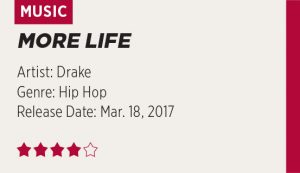REVIEW: Drake’s More Life reveals originality in production
Music distribution has changed drastically over the last few years. With the introduction of streaming platforms like Spotify, Tidal and Apple Music, artists have tailored their marketing strategies to fit in with new trends in music streaming. One such artist is R&B and hip-hop artist Drake.
In 2016, Drake released his fourth and most commercially successful studio album Views. The album broke sales records and set a new trend for streaming in the new age of music. While Views failed to garner the critical acclaim of the rapper’s earlier work, it was a major success among fans and led to a stadium tour that only further established Drake as the biggest rapper in music today.
In keeping with the momentum of his Summer Sixteen Tour, Drake announced his new playlist More Life on March 18. The collection of songs contains 22 tracks and is equal in length to Views. What sets the work apart from a mixtape or studio album is its informal presentation. It plays as more of several glimpses into Drake’s life than a cohesive work. More Life is better than Views in several ways, and Drake brilliantly utilizes a new and original marketing strategy to release the project.
 Drake and his label OVO debuted the playlist More Life on the 39th episode of OVO Sound Radio, a radio station on the streaming platform Apple Music. This release strategy allowed Drake to be more experimental with the work. Instead of seeking to develop a cohesive body of work with a single concept like Views attempted to do, Drake was able to release a work that played as more of a stream of consciousness. More Life succeeds in the areas that Views fails because of its branding as a playlist.
Drake and his label OVO debuted the playlist More Life on the 39th episode of OVO Sound Radio, a radio station on the streaming platform Apple Music. This release strategy allowed Drake to be more experimental with the work. Instead of seeking to develop a cohesive body of work with a single concept like Views attempted to do, Drake was able to release a work that played as more of a stream of consciousness. More Life succeeds in the areas that Views fails because of its branding as a playlist.
The work opens with back to back uptempo tracks “Free Smoke” and “No Long Talk (feat. Giggs).” With these introductory songs, Drake reminds his listeners that he’s still the champion of rap and can set aside his softer side, replacing it with harder flows. After these tracks, though, Drake returns to his successful dancehall formula with the tracks “Passionfruit,” “Get it Together,” “Madiba Riddim” and “Blem.”
While some of these tracks are far stronger than others, their aesthetic is comforting and provides fans of “One Dance” and “Controlla” with more of the same. One track, “Jorja’s Interlude,” even contains a sample of Drake’s own “Doing It Wrong,” implying Drake’s seeking to reclaim the glory associated with his peak with 2011’s Take Care.
While the curation of More Life is impressive and original, it does not tread much new ground in terms of content. Like in Views, Drake is still plagued by the alienation of being at the top of the music industry, and he remains skeptical of his peers and ex-girlfriends. This topic is what heavily burdened Views, and it weighs down More Life as well.
What’s most interesting is that these attitudes possessed by Drake are addressed by his own mother on the track “Can’t Have Everything.” Drake raps about his mom telling him to stop worrying about other people’s opinions and having a more positive mindset. There are a few glimpses into the heights Drake can reach, with tracks like “Lose You,” “Ice Melts (feat. Young Thug)” and “Do Not Disturb.” “Ice Melts” provided a lighter tone that was absent from the overserious Views, and More Life could have benefited from more tracks like it. While More Life indulges in a lot of the same subject matter, it shows Drake working to return to form.
In terms of content, More Life is typical Drake. It shows him using the same conversation topics to say the same thing. Stylistically, however, More Life is incredibly impressive. Featuring popular artists and rappers such as Young Thug, Travis Scott, Sampha and Quavo, More Life diversifies Drake’s musical style. “Do Not Disturb” is a featured outtro that perfectly reflects the playlist’s nuances. While inconsistent in quality, More Life is an ambitious addition to Drake’s discography.

